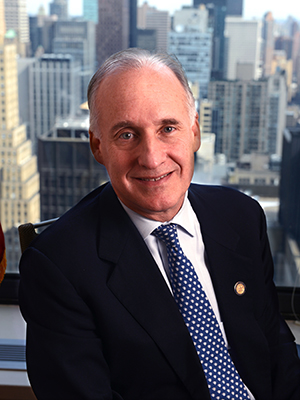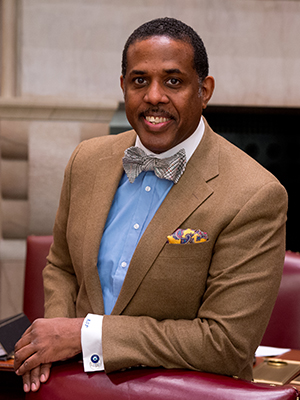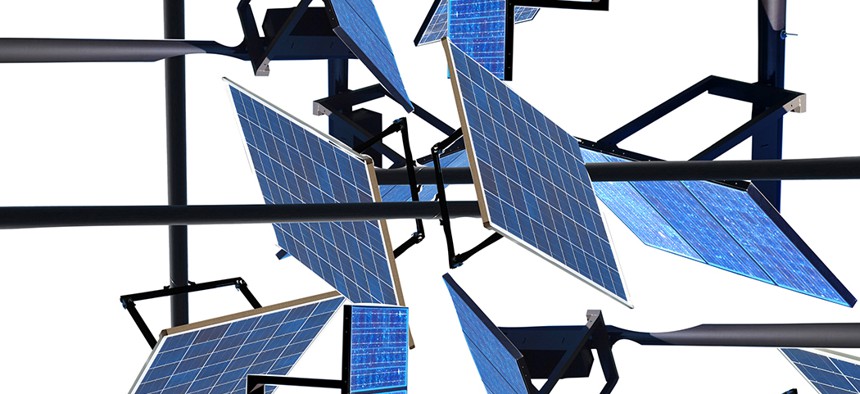President Donald Trump has reversed course on major energy policies since taking office last year, from pulling out of the Paris climate agreement to opening up offshore drilling to installing industry allies to key posts. But the federal changes haven’t yet had much of an impact on New York, where Gov. Andrew Cuomo has been carrying out his own set of energy initiatives. City & State spoke with state Chairman of Energy and Finance Richard Kauffman, Assembly Energy Committee Chairman Michael Cusick and Ranking Member of the state Senate Energy and Telecommunications Committee Kevin Parker to assess the governor’s ambitious efforts to shift to renewables and whether New York is meeting its goals.
On track with offshore wind

State Chairman of Energy and Finance
The Trump administration has made changes in energy policy, recently rolling back some car emissions standards, while tariffs may affect the solar power industry. Has this affected energy policy in New York?
We began, under the governor’s leadership, a change in energy policy over five years ago. And these changes in policy weren’t based upon the Obama administration, weren’t based upon the Clean Power Plan. … Everything we’ve done in the last five years had relied upon state authorities and prerogatives. So, with respect to the Trump administration, there are some areas where we work collaboratively with the administration. For example, on offshore wind. I think we’ve had a constructive relationship with the administration in the development of offshore wind resources. But there are other areas where we have relatively profound disagreements. So, as the governor made very clear, we will take to the beaches to fight against offshore oil and gas development. We will be shutting down the remaining coal power plants in the state.
Why has New York has been pursuing offshore wind?
Well, offshore wind has tremendous resource potential. The cost of offshore wind, because of development in Europe, has significantly declined. But the benefit of offshore wind in New York state is that most of where the demand for power is in the state is downstate, Long Island and the areas around New York City. And that’s where the offshore wind resources are obviously located. And so the opportunity to minimize new transmission – which would otherwise have to be built upstate if we just relied upon onshore resources – also means lower costs. So you have those benefits and beyond that, we see that there’s economic development opportunities that will come from development of an offshore wind industry – because it’s just not New York state – but many of the states on the East Coast are interested in developing their offshore wind resources as well.
Where do you see the development of offshore wind going in the next few years in New York?
We’ve been working on the approach to offshore wind for really quite a number of years. And we have approached offshore wind not just as a single project but as how to think of the development of an entire industry and an entire market. … We organized a multistate collaborative that … dates back two or three years ago. And then we developed an offshore wind master plan, and the result of that offshore wind master plan – we’re now going to do the first procurement of a minimum of 400 megawatts by the end of this year and at least another 400 megawatts of procurement in 2019. And this is against the objective that the governor has laid out of 2.4 gigawatts … by 2030.
With Indian Point Energy Center closing down, there’s going to be a decrease in how much nuclear energy the state is producing. How is the state filling in the gaps?
There are a number of steps that have already been taken in terms of additional transmission, energy efficiency. … The negotiation for the closure allows for additional time for resources to be brought on by the market. So there are a variety of resources that the market will provide.
In the past, the state has set goals of hitting a certain amount of renewables, but those goals have failed in the past. What do you think the state is doing to prevent that from happening again?
We’re very mindful of that. And that’s why the “50 by 30” is not a goal but a mandate. So it imposes a requirement on the utilities, on what are otherwise called load-serving entities, to procure a certain amount of renewable energy on behalf of customers every year.
Renewables could raise prices for ratepayers. How is the state trying to keep the cost of electricity low?
If we continue to follow the old policy, it’s true, the cost would become high because it would continue to add more and more resources onto a system that was not designed for those resources. But taking an integrated approach means that we can then add renewables in ways where we can accommodate the intermittency of renewables through storage and through, again, demand-side resources and, in addition, deploy distributed solutions on solar in areas of the grid where it actually saves customers money.
What about “80 by 50”?

Ranking Member, state Senate Energy and Telecommunications Committee
What renewable energy bills would you like to pass, but haven’t been able to because of opposition from state Senate Republicans?
We have a bill that is a “80 by 50” bill – 80 percent renewable by 2050 – that I would love to see done in terms of the Renewable Portfolio Standard, which I think is really important. … We have no real action on a standardized core around the state around siting solar. So let’s say you’re in the Bronx siting a project for solar and you go across the street into Yonkers, it’s a whole different code because it’s a whole different town. We really need to find a way to unify the building codes as it relates to solar across the state so that it makes it easier for people to site projects.
You mentioned this bill to have “80 by 50,” so I imagine you think that the governor’s current plan to have 50 percent of electricity generated from renewable energy by 2030 is also feasible?
Absolutely. It is ambitious, but it is doable.
Why do you think it can be accomplished by 2030? What aspects of the plan do you think make that a plausible goal?
We already have one of the most robust hydroelectric efforts in the entire country going on in New York in terms of the numbers of hydroelectric facilities we have in the state. Wind is picking up a great deal, particularly offshore wind, especially a couple of projects we hope to have online by the beginning of next year. And solar is, again, very robust in the state. And through the NY-Sun program, run out of NYSERDA, you know the governor’s put up $1 billion toward solar projects. There’s no other state doing nearly that much money in terms of encouraging solar projects. I think that the state has allocated the resources. I think it’s now the work of NYSERDA and the PSC to get projects in the pipeline and complete.
It’s not going to be an easy battle to get more offshore wind farms. What kinds of challenges do you anticipate?
Offshore has been more controversial than onshore because lots of rural areas and farms have welcomed wind with open arms. … I think the more people learn about offshore wind, the more they’re going to like it. Some people complained about the shorelines and visibility – most of these offshore projects you can’t see with the naked eye from shore.
Where do you see nuclear fitting in here?
Nuclear is not 100 percent renewable. I have never argued it should be part of the RPS. I do see it as a bridge fuel though. So I’m not a proponent for building additional nuclear, but I don’t oppose existing nuclear. And I think existing nuclear – and I think that also with natural gas – it’s going to be needed to be used as bridge fuels between now and a time that we actually get the rest of the renewable sources online.
Are the Trump administration’s policies having any impact on renewable energy?
Absolutely, I think in two ways. The first, obviously tariffs on things like solar panels and machinery that we would buying from China or other countries in terms of sustainable energy production. To a certain degree, it’s been a positive impact, to this point, because it’s balanced the equation between foreign systems and domestic systems. A lot more people, to my understanding, are buying domestic systems now because of the equalization of the cost. I think that everybody generally thinks that the U.S. opting out of the Paris climate accord was probably a negative thing. It certainly has put a lot of, we believe, pressure on states in order to do the work that really the federal government should be helping in.
Why battery storage is crucial

Chairman, Assembly Energy Committee
You had sponsored a bill about battery storage. I was interested in hearing a bit more about why you sponsored it.
The committee focused this year, and we continue to focus on battery storage. A major reason to deploy more energy storage relates (to) the intermittent nature of renewables. We want to store the energy, to have the energy that these renewables are producing. But because of, sometimes, the unpredictability of the producing element, we want to make sure the energy is still there. So storage is very important and that is why we put a focus on that this session. We will continue to do that into next session. And it goes into also what the governor and his administration had been doing this session too.
Do you support the state’s recent push for more offshore wind production?
We are working with the administration on their proposed plan, for the Offshore Wind Master Plan. The Assembly committee doesn’t take positions on issues related to what’s going on in the administration, but there are many members of the committee that do support the offshore wind plan of the governor. We are excited to look at any advancements in capturing wind energy. It is something we are supportive of as individual members of the committee.
Is there anything else the Assembly is thinking of doing to hit this goal of getting 50 percent of the state’s electricity from renewable sources by 2030?
There are many bills that provide incentives, whether they’re incentives to businesses or to utilities or to customers themselves. … It’s encouraging the use of renewables, whether it’s wind or solar. There are many bills in our committee that address that.
Have you seen any differences with the Trump administration as far as energy policies?
Well you mentioned offshore wind. Some of what comes out of the administration in DC will affect that, in that the issue of offshore drilling is front and center in this administration and that would be contradictory to the offshore wind plan that the governor has. Also, the EPA rollback of vehicle pollution standards would hurt in New York in various ways. The rollbacks, we believe, would counter New York’s “50 by 2030” goal. It’s areas like that that make it difficult for New York.


